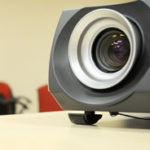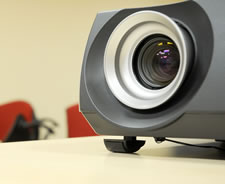
Not every college classroom is a vast lecture hall. There are dozens, sometimes hundreds, of small rooms on campus that serve as meeting spaces for small class sections—confined areas where projectors can be placed just a couple feet away.
Casting a large, clear picture on a screen or wall is rarely a challenge in the most spacious of lecture halls; professors can place their projectors as far back into the room as needed in order to get a crisp image that supplements a class lesson.
For faculty members who don’t have the luxury of nearly unlimited space, however, there is a new generation of short-throw projectors that have adopted a new name: “ultra short throw” or “extreme short throw.”
These extreme versions of the short-throw projector can create images up to 80 inches diagonally across, sitting only two feet away from a screen or wall—making the machines ideal for educators working in a tight space.
Having the projector so close to the wall also lets professors and teaching assistants roam the classroom without casting shadows on the projection, experts say.
“This past year it’s been all about who puts the ‘short’ in short-throw projectors,” said Elizabeth Dourley, a researcher and writer for Projector Central, a website that tracks projector technology for entertainment and educational use. “Short throws are extremely popular for applications where space is tight, but they also prevent light hitting a presenter in the face or shadows obstructing the image.”
Many extreme short-throw projectors require only about one foot to produce an image—a significant difference when compared to a standard projector used in higher education. Traditional projectors need at least eight feet to cast a clear image on a wall or screen, and many need several more feet to operate.
Ultra short-throw projectors have developed a following both in K-12 schools and on college campuses, Dourley said. And she expects the educational fascination with short-throw projectors to continue in 2011.
“Short-throw projectors have always been favored by schools, because of space constraints and other issues,” she said.
The most extreme of the extreme short-throw projectors
Many projector companies have unveiled their latest lines of ultra short-throw options in recent months, but few—if any—compare to the limited distance needed by the Dell S500wi projector, which hit the market in February.
Projector Central researchers and analysts, during tests with the Dell product, found the S500wi produced a 75-inch diagonal image (63 inches wide) sitting only five inches from the screen.
From just two feet, the projector can create an image measuring 100 inches diagonally, according to Dell.
Dell’s latest ultra short-throw projector, along with many others on the market, doesn’t require the pesky task of calibrating the on-screen image every time the projector is moved, even by a few inches. This can be particularly useful for educators who move projectors around the classroom on carts.
The S500wi, like others in the extreme short-throw category, can create large images from less than a foot away from the screen by reflecting the image off a mirror.
There are, however, new extreme short-throws that avoid the use of mirrors, which experts say can degrade the on-screen image, if only slightly.
Mitsubishi’s WD380U-EST and XD380U-EST extreme short-throw projectors don’t rely on mirrors to cast a large image from a short space, but instead employ specialty lenses introduced by the company in May.
The newest Mitsubishi line of ultra short-throws requires more space in front of the screen or wall—about two feet instead of the five inches needed for the Dell projector—but the company claims it provides a clearer image for educators and their students.
“It’s technological prowess that we use to create imaging wonder, not smoke and mirrors,” said Wayne Kozuki, product manager for Mitsubishi Digital Electronics.
Mitsubishi’s latest short-throw machine features a lamp life of up to 6,000 hours if left on “low mode” and a built-in 10-watt speaker, which will work even if the projector is left on standby mode. This would allow professors to save lamp life by shutting down the projector’s visual component without sacrificing audio that could be crucial to a presentation or lecture.
Panasonic’s PT-ST10 is another short-throw projector that needs less than two feet of space to operate. The short-throw projector can be attached to Panasonic’s whiteboard, known as the Panaboard, using an attachment piece stemming from the top of the whiteboard.
Projector Central has a tool that can take the guessing out of projector choices, especially for faculty members unsure of which projector to request for their classroom with limited space.
The website’s “Projection Calculator Pro” helps educators understand which machines will fit in the available room space. Using manufacturer-supplied specifics on a range of projectors, Projector Central’s calculator accounts for screen size, room lighting, and—of course—the number of feet a professor has between a projector cart and a screen or wall.
Leading technology companies also have released products made for enhancing short-throw projectors in the classroom or lecture hall.
Texas-based Extron Electronics was among those companies at last year’s InfoComm in Las Vegas, where it displayed its WallVault Systems that are designed for classrooms with a wall-mounted short-throw projector or flat-panel display.
WallVault Systems include all the necessary audio and video switching, sound amplification, system control, source connectivity, speakers, mounting hardware, and cabling for a complete classroom audio-video solution, the company says; all that’s left to add is the video projector or flat-panel display itself.
Instructors can control their projectors or flat-panel displays through a wall-mounted controller, switching back and forth between a computer, DVD, VCR, or other media source connected to the display, adjusting the volume as necessary. Or, they can control the system via the school’s network, using a graphical interface on a webpage.
Affordable ‘non-extreme’ short throws
Not every extreme short-throw projector can cast images on screen from just five inches away, but the projector market is full of options that work from a few feet away and are more affordable for colleges and universities with tight technology budgets.
NEC’s NP-M300WS, for example, is available for $1,099. The projector’s LCD display can produce a crisp image from just 22 inches away from a screen, according to the company. And with a lamp life of 3,500 hours, campus IT officials won’t have to buy replacement bulbs every few months.
The Sanyo PDG-DWL100 is another low-price short-throw option for campus classrooms with tight classroom spaces. The Sanyo projector can cast images from as little as 20 inches away from a screen or wall, and at 39 inches, the projector can produce an 80-inch image.
Dell’s M410HD is also among affordable short-throw projectors that could be a top choice in higher education. For $859, college faculty can have a projector that can fill a screen from just over three feet away.
- Research: Social media has negative impact on academic performance - April 2, 2020
- Number 1: Social media has negative impact on academic performance - December 31, 2014
- 6 reasons campus networks must change - September 30, 2014

